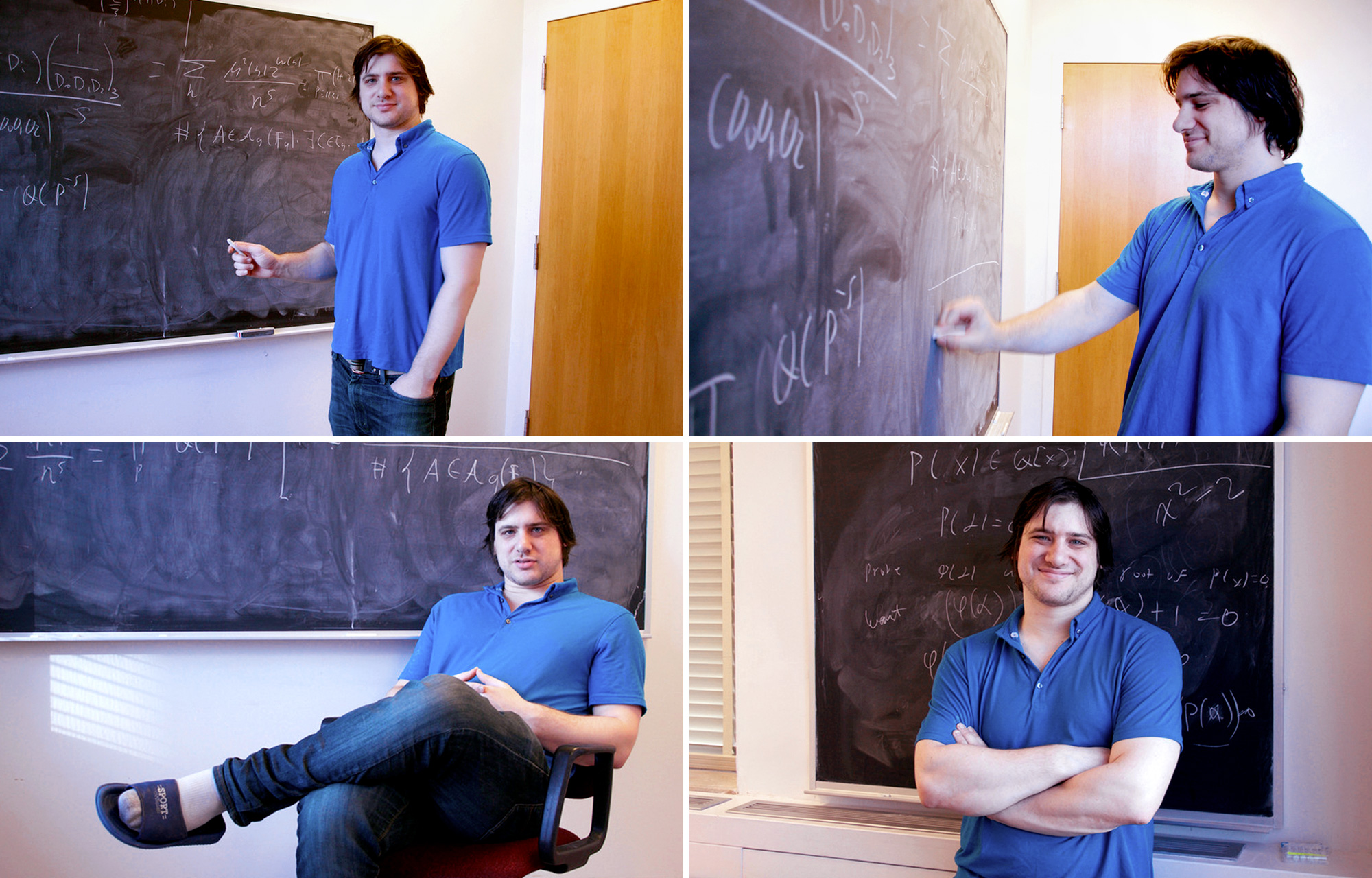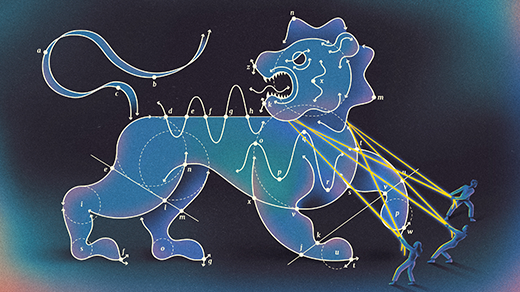Mathematicians Prove 30-Year-Old André-Oort Conjecture

An illustration of a modular curve, a one-dimensional version a Shimura variety.
Samuel Velasco/Quanta Magazine; source: Kilom691 and Alexander Hulpke
Introduction
In a striking proof posted in September, three mathematicians have solved a 30-year-old problem called the André-Oort conjecture and advanced the centuries-long quest to understand the solutions of polynomial equations. The work draws on ideas that span nearly the breadth of the field.
“The methods used to approach it cover, I would say, the whole of mathematics,” said Andrei Yafaev of University College London.
The new paper begins with one of the most basic but provocative questions in mathematics: When do polynomial equations like x3 + y3 = z3 have integer solutions (solutions in the positive and negative counting numbers)? In 1994, Andrew Wiles solved a version of this question, known as Fermat’s Last Theorem, in one of the great mathematical triumphs of the 20th century.
In the quest to solve Fermat’s Last Theorem and problems like it, mathematicians have developed increasingly abstract theories that spark new questions and conjectures. Two such problems, stated in 1989 and 1995 by Yves André and Frans Oort, respectively, led to what’s now known as the André-Oort conjecture. Instead of asking about integer solutions to polynomial equations, the André-Oort conjecture is about solutions involving far more complicated geometric objects called Shimura varieties.
Many mathematicians have worked on the problem in the last few decades. In 2014, Yafaev and Bruno Klingler proved it, but with a catch. Their result depended on the Riemann hypothesis being true — but that famously hard question remains unsolved.
The new paper by Jonathan Pila of the University of Oxford, Ananth Shankar of the University of Wisconsin and Jacob Tsimerman of the University of Toronto resolves this gap with a definitive solution. It also further confirms the talent of Tsimerman, 33, who is widely regarded as one of the top mathematicians of his generation.
“Jacob Tsimerman has this ability to understand everything,” said Yafaev.
Various Varieties
The André-Oort conjecture is about algebraic varieties, which at their most basic level are just the set (or graph) of all the solutions to one polynomial equation or a collection of them.
A circle of radius 1 is a variety: The coordinates of its points are solutions to the polynomial x2 + y2 = 1. The line y = 0 is also a variety. And the intersection of these two — the points (1, 0) and (−1, 0) — is yet a third variety nested within the first two.
The varieties at the heart of the André-Oort conjecture are an important type, called Shimura varieties. While there are a few different types of Shimura varieties, the simplest ones relate to critical mathematical objects called elliptic curves (equations like y2 = x3 + 1, or y2 = x3 + 3x + 2).
The points on these Shimura varieties each encode a recipe for constructing an elliptic curve. But there are other, more complicated Shimura varieties whose structure is less straightforward. Pinning down information about them has been difficult.
“You really know little about the structure of general-type Shimura varieties,” said Ruochuan Liu of Peking University.
The André-Oort conjecture is a question about just that: What is the basic structure of Shimura varieties, which themselves underpin a lot of modern mathematics?
Special Points
Remember, varieties can live within varieties, the way the non-tangent intersection of a line and a circle creates a subvariety of two points. The André-Oort conjecture asks about varieties that live inside Shimura varieties. It does this by focusing on particular elements of Shimura varieties.
On a Shimura variety, each point represents another variety, such as an elliptic curve. Some of those curves have more symmetry than others, and those that do are represented on the Shimura variety by what mathematicians call “special points.”
The André-Oort conjecture is about how these special points are distributed. Imagine starting with a Shimura variety. Think of it as a three-dimensional shape. Next, etch a curve across its surface. This curve is a variety, though not necessarily a Shimura variety. But according to the André-Oort conjecture, if that curve is constantly running into special points, it must itself be a Shimura variety.
“It’s sort of a very clean geometric interpretation,” said Tsimerman.

Jacob Tsimerman’s involvement with the André-Oort conjecture picked up in graduate school when a former student came back for a visit.
Diana Tyszko/University of Toronto
Stated differently, the André-Oort conjecture makes predictions in the case where the etched curve is not a Shimura variety. Then, there’s a ceiling on the number of special points it can possibly run into. Mathematicians have been trying for years to verify the ceiling predicted by André and Oort. At the end of the 2000s, Jonathan Pila made significant progress toward establishing it when he introduced a new method for counting special points.
Pila’s Progress
To prove the André-Oort conjecture, Pila needed to get a rough idea of the number of special points on a variety. He did this by assigning points a quantity known as a “height.” Height measures how complicated a particular point, or value, is. Consider the numbers 10 and 10.000017. On the one hand, they’re very similar, but on the other, they’re obviously very different.
“These are both rational numbers, and they are pretty close in size. But one of them is a lot more complex than the other,” said Shankar.
One way to quantify this complexity is to convert these numbers into simplified fractions. The height of a number is the absolute value of the numerator or denominator of that fraction — whichever is larger. As a fraction, the number 10 is the same as $latex \frac{10}{1}$, so the height of 10 is 10. But the simplest way of rewriting 10.000017 as a fraction is as $latex \frac{10,000,017}{1,000,000}$. This makes its height around 10 million. There are other ways of measuring height as well (a fact that turned out to be a principal challenge for the authors of the new work).
To prove the André-Oort conjecture, Pila needed to show that a non-Shimura variety living inside a Shimura variety doesn’t have a lot of special points. Height is a helpful tool for doing this.
To see why, think about the rational numbers whose height is at most 2. Even though there are infinitely many rational numbers with an absolute value of 2 or less, only seven of them are simple enough to have a height that’s 2 or less: 0, 1, $latex \frac{1}{2}$, 2, or one of their negatives. In general, if you can prove that the heights on a set of rational numbers have a ceiling, you’ve proved that the set has a finite number of elements.
In this way, height is quite different from absolute value. Pila took advantage of this difference by identifying each special point on a Shimura variety with a different real number. He then proved that those associated real numbers weren’t too complex — their heights couldn’t be too big. That meant there were finitely many real numbers associated to special points. Since each special point corresponded to a distinct real number, there could only be a finite number of special points too.
Pila’s method cleverly avoided calculating heights on the Shimura variety itself. Instead, he studied the heights of real numbers and connected the real numbers to the Shimura variety. But this strategy only worked for very simple Shimura varieties.
To prove the André-Oort conjecture on all Shimura varieties, he and others would need to come up with a way to measure heights directly.
Universal Heights
While Pila was making exciting new advances on the André-Oort conjecture, Tsimerman was still a graduate student at Princeton University. He had started working on the problem at the suggestion of his adviser, Peter Sarnak. Pila had also been a student of Sarnak’s, and when he returned to Princeton in 2009 to share his new findings, he and Tsimerman hit it off.
“Him and I have been working on it ever since,” said Tsimerman.
The biggest obstacle they faced was in braiding together the many different ways of measuring height. For example, sometimes mathematicians define the size of a number by looking at its prime factors instead of its absolute value. To answer the André-Oort conjecture, the authors first needed to translate each of these definitions of complexity to Shimura varieties.
Pila and Tsimerman made partial progress in this direction. But advancing further required complicated mathematical ideas that they were less familiar with. In particular, they needed to find a way to combine all these different ways of measuring height into a single coherent number (which would ensure that they had accounted for all the ways in which points might differ from one another).
Tsimerman knew that Shankar had experience with the kind of mathematics that they needed to accomplish this and invited him to join the collaboration in August 2020. The three authors worked on the problem for several months, with halting progress.
“It sometimes seemed we were close; it sometimes seemed that there were fundamental obstacles that were hard to overcome,” said Shankar. They decided to take a step back last winter, thinking they would make better progress elsewhere.
A couple of months later, Shankar introduced Pila and Tsimerman to work by Michael Groechenig of the University of Toronto and Hélène Esnault of the Free University of Berlin after seeing a talk by Groechenig. He suspected that their results — plus work by Gal Binyamini and others — could help to prove that all the different notions of height merge the way the three authors needed.
That hunch turned out to be correct, once Esnault and Groechenig added to their previous work. Pila, Shankar and Tsimerman then used the expanded version to prove that the heights of special points never get too big, for any type of Shimura variety. With that, a full proof of the André-Oort conjecture was within reach.
“In some sense the punchline to the paper was clear, like, a year and a half ago, but then to get it working required developing this kind of complicated piece of machinery that took a long time to get right,” said Tsimerman.
Pila, Shankar and Tsimerman finally posted the paper this fall. They proved that any variety living inside a Shimura variety can’t have too many special points without being a Shimura variety itself.
Though reading and verifying the paper carefully will take time, mathematicians are already reflecting on its impact. If the paper’s ideas can be applied more broadly, for example, they might extend a major result from the 1980s about a problem called the Mordell conjecture — a feat that would trigger an avalanche of new results in number theory.
“This is a breakthrough, definitely a breakthrough,” said Liu.



